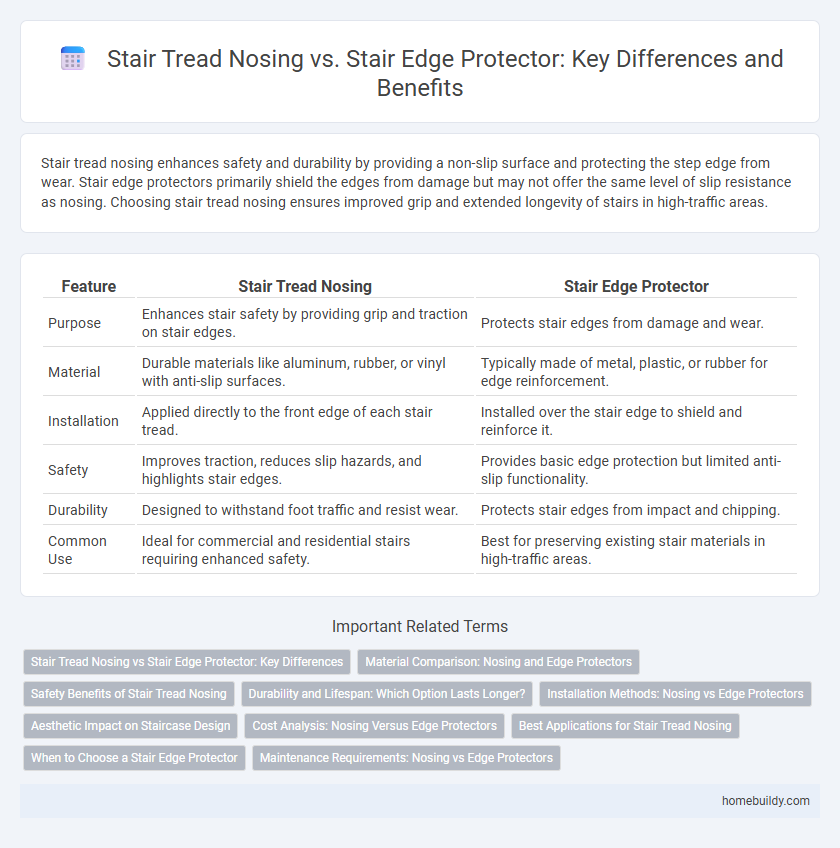Stair tread nosing enhances safety and durability by providing a non-slip surface and protecting the step edge from wear. Stair edge protectors primarily shield the edges from damage but may not offer the same level of slip resistance as nosing. Choosing stair tread nosing ensures improved grip and extended longevity of stairs in high-traffic areas.
Table of Comparison
| Feature | Stair Tread Nosing | Stair Edge Protector |
|---|---|---|
| Purpose | Enhances stair safety by providing grip and traction on stair edges. | Protects stair edges from damage and wear. |
| Material | Durable materials like aluminum, rubber, or vinyl with anti-slip surfaces. | Typically made of metal, plastic, or rubber for edge reinforcement. |
| Installation | Applied directly to the front edge of each stair tread. | Installed over the stair edge to shield and reinforce it. |
| Safety | Improves traction, reduces slip hazards, and highlights stair edges. | Provides basic edge protection but limited anti-slip functionality. |
| Durability | Designed to withstand foot traffic and resist wear. | Protects stair edges from impact and chipping. |
| Common Use | Ideal for commercial and residential stairs requiring enhanced safety. | Best for preserving existing stair materials in high-traffic areas. |
Stair Tread Nosing vs Stair Edge Protector: Key Differences
Stair tread nosing refers to the rounded or angled front edge of a stair tread, designed to enhance safety by providing better grip and visibility while also protecting the stairs from wear. Stair edge protectors are additional fittings applied to the stair edge, often made from metal, rubber, or vinyl, to shield against damage and reduce slip risks. The key difference lies in their installation and function: stair tread nosing is an integral part of the stair design or a retrofit added to the tread itself, whereas stair edge protectors are external attachments focused primarily on protection and safety enhancement.
Material Comparison: Nosing and Edge Protectors
Stair tread nosing typically uses durable materials like aluminum, PVC, or rubber to enhance traction and visibility, ensuring safety and wear resistance. Stair edge protectors often employ similar materials but may include heavy-duty options such as stainless steel or brass for superior impact resistance and longevity. Comparing materials, nosing focuses on slip resistance and visibility, while edge protectors prioritize robust edge reinforcement and damage prevention.
Safety Benefits of Stair Tread Nosing
Stair tread nosing enhances safety by providing improved traction and visibility on stair edges, reducing the risk of slips and falls. It extends the stair tread surface, offering better foot placement and stability compared to standard stair edge protectors. Durable materials and anti-slip designs ensure long-lasting performance in high-traffic areas, making stair tread nosing a critical safety feature.
Durability and Lifespan: Which Option Lasts Longer?
Stair tread nosing, typically made from durable materials like aluminum or rubber, is specifically designed to withstand heavy foot traffic and resist wear, resulting in a longer lifespan compared to standard stair edge protectors. Stair edge protectors, often thinner and less robust, may degrade faster under constant use and exposure to elements. Choosing stair tread nosing ensures enhanced durability and prolonged performance, making it a more cost-effective solution over time.
Installation Methods: Nosing vs Edge Protectors
Stair tread nosing installation typically involves securing the nosing directly to the stair tread using screws, adhesives, or a combination, ensuring a flush fit for enhanced safety and durability. Stair edge protectors are generally installed by attaching them over the stair edge with mechanical fasteners like screws or nails, often requiring pre-drilled holes to accommodate different stair materials. While nosing installation demands precise alignment to maintain the stair profile, edge protectors offer a more straightforward, surface-level attachment.
Aesthetic Impact on Staircase Design
Stair tread nosing provides a seamless integration with the stair profile, enhancing the overall aesthetic appeal by maintaining the natural lines and materials of the staircase. In contrast, stair edge protectors, often made from contrasting metal or plastic, can create a visual interruption that may detract from the design cohesion. Choosing stair tread nosing allows for a subtle, elegant finish that complements both traditional and modern stair designs.
Cost Analysis: Nosing Versus Edge Protectors
Stair tread nosing generally offers a more cost-effective solution compared to stair edge protectors due to lower material and installation expenses, especially in residential settings. While edge protectors provide enhanced durability and impact resistance, their higher upfront cost and maintenance requirements can increase overall project budgets. Evaluating long-term benefits and usage environments is essential for determining the most economical choice between nosing and edge protectors.
Best Applications for Stair Tread Nosing
Stair tread nosing is best applied in high-traffic areas where enhanced safety and durability are critical, such as commercial buildings, schools, and public facilities. It provides superior slip resistance and edge protection by extending the stair tread surface, reducing wear and tear while improving visibility. Unlike stair edge protectors, stair tread nosing seamlessly integrates with the tread design, making it ideal for both new construction and stair renovation projects requiring long-lasting performance.
When to Choose a Stair Edge Protector
Stair edge protectors are essential when additional safety and durability are required in high-traffic areas or commercial settings to prevent wear and reduce slip hazards. Unlike stair tread nosing, edge protectors offer a reinforced barrier that guards the stair edges from damage and provides enhanced grip. Choosing a stair edge protector is ideal for environments where heavy foot traffic or equipment use increases the risk of stair edge deterioration.
Maintenance Requirements: Nosing vs Edge Protectors
Stair tread nosing typically demands less maintenance due to its seamless integration with the stair tread, minimizing dirt accumulation and wear. Stair edge protectors, while offering robust protection against edge damage, often require regular inspection and cleaning to prevent dirt buildup and potential detachment. Choosing stair tread nosing can reduce long-term maintenance efforts, ensuring durability and safety with minimal upkeep.
Stair tread nosing vs stair edge protector Infographic

 homebuildy.com
homebuildy.com